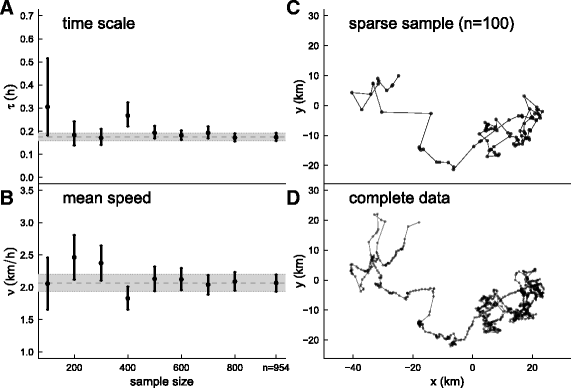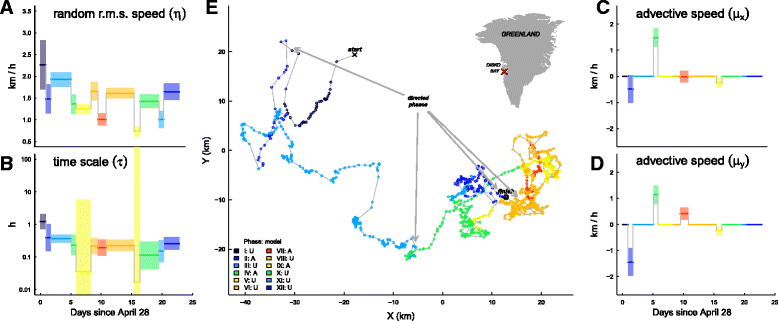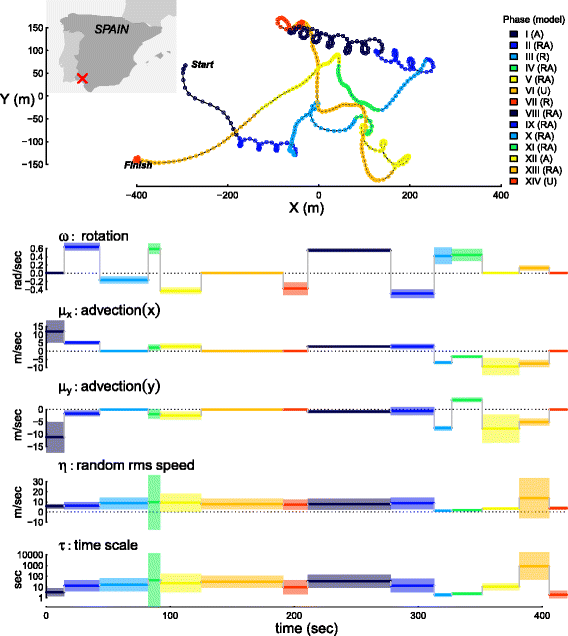Correlated velocity models as a fundamental unit of animal movement: synthesis and applications
- PMID: 28496983
- PMCID: PMC5424322
- DOI: 10.1186/s40462-017-0103-3
Correlated velocity models as a fundamental unit of animal movement: synthesis and applications
Abstract
Background: Continuous time movement models resolve many of the problems with scaling, sampling, and interpretation that affect discrete movement models. They can, however, be challenging to estimate, have been presented in inconsistent ways, and are not widely used.
Methods: We review the literature on integrated Ornstein-Uhlenbeck velocity models and propose four fundamental correlated velocity movement models (CVM's): random, advective, rotational, and rotational-advective. The models are defined in terms of biologically meaningful speeds and time scales of autocorrelation. We summarize several approaches to estimating the models, and apply these tools for the higher order task of behavioral partitioning via change point analysis.
Results: An array of simulation illustrate the precision and accuracy of the estimation tools. An analysis of a swimming track of a bowhead whale (Balaena mysticetus) illustrates their robustness to irregular and sparse sampling and identifies switches between slower and faster, and directed vs. random movements. An analysis of a short flight of a lesser kestrel (Falco naumanni) identifies exact moments when switches occur between loopy, thermal soaring and directed flapping or gliding flights.
Conclusions: We provide tools to estimate parameters and perform change point analyses in continuous time movement models as an R package (smoove). These resources, together with the synthesis, should facilitate the wider application and development of correlated velocity models among movement ecologists.
Keywords: Balaena mysticetus; Correlated random walk; Correlated velocity movement; Falco naumanni; Integrated Ornstein-Uhlenbeck process; Thermal soaring; Velocity autocovariance function.
Figures




Similar articles
-
Exact solution for the Anisotropic Ornstein-Uhlenbeck process.Physica A. 2022 Feb 1;587:126526. doi: 10.1016/j.physa.2021.126526. Epub 2021 Oct 19. Physica A. 2022. PMID: 36937094 Free PMC article.
-
Modeling interdependent animal movement in continuous time.Biometrics. 2016 Jun;72(2):315-24. doi: 10.1111/biom.12454. Epub 2016 Jan 26. Biometrics. 2016. PMID: 26812666
-
Combined use of tri-axial accelerometers and GPS reveals the flexible foraging strategy of a bird in relation to weather conditions.PLoS One. 2017 Jun 7;12(6):e0177892. doi: 10.1371/journal.pone.0177892. eCollection 2017. PLoS One. 2017. PMID: 28591181 Free PMC article.
-
Characteristic spatial and temporal scales unify models of animal movement.Am Nat. 2011 Jul;178(1):113-23. doi: 10.1086/660285. Am Nat. 2011. PMID: 21670582
-
Decision-making by a soaring bird: time, energy and risk considerations at different spatio-temporal scales.Philos Trans R Soc Lond B Biol Sci. 2016 Sep 26;371(1704):20150397. doi: 10.1098/rstb.2015.0397. Philos Trans R Soc Lond B Biol Sci. 2016. PMID: 27528787 Free PMC article.
Cited by
-
Inferring spatially varying animal movement characteristics using a hierarchical continuous-time velocity model.Ecol Lett. 2022 Dec;25(12):2726-2738. doi: 10.1111/ele.14117. Epub 2022 Oct 18. Ecol Lett. 2022. PMID: 36256526 Free PMC article.
-
Circular-linear copulae for animal movement data.Methods Ecol Evol. 2022 May;13(5):1001-1013. doi: 10.1111/2041-210X.13821. Epub 2022 Mar 1. Methods Ecol Evol. 2022. PMID: 35915739 Free PMC article.
-
Ants combine systematic meandering and correlated random walks when searching for unknown resources.iScience. 2023 Jan 30;26(2):105916. doi: 10.1016/j.isci.2022.105916. eCollection 2023 Feb 17. iScience. 2023. PMID: 36866038 Free PMC article.
-
Categorizing the geometry of animal diel movement patterns with examples from high-resolution barn owl tracking.Mov Ecol. 2023 Mar 21;11(1):15. doi: 10.1186/s40462-023-00367-4. Mov Ecol. 2023. PMID: 36945057 Free PMC article.
-
Generalizing the first-difference correlated random walk for marine animal movement data.Sci Rep. 2019 Mar 8;9(1):4017. doi: 10.1038/s41598-019-40405-z. Sci Rep. 2019. PMID: 30850659 Free PMC article.
References
-
- Patlak CS. A mathematical contribution to the study of orientation of organisms. Bull Math Biophys. 1953;15:431–76. doi: 10.1007/BF02476435. - DOI
LinkOut - more resources
Full Text Sources
Other Literature Sources

